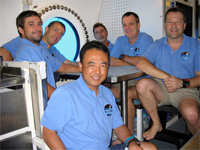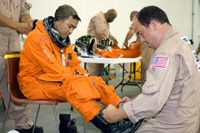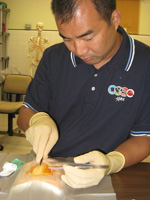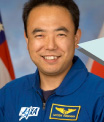JAXA Astronaut Activity Report, August 2007
Last Updated: October 22, 2007
This is JAXA's Japanese astronaut primary activity report for August 2007.
The 13th NASA Extreme Environment Mission Operations (NEEMO)

NEEMO 13 crew members aboard Aquarius (Astronaut Furukawa in the front-middle) (© NASA/NOAA/UNCW)
Astronaut Furukawa participated in the 13th NASA Extreme Environment Mission Operations (NEEMO) training that was conducted using “Aquarius,” the underwater laboratory owned by the National Oceanic and Atmospheric Administration (NOAA). Aquarius is located off the coast of Florida at a depth of about 20 meters.
The purpose of NEEMO is to simulate long-duration space flight and to foster leadership, teamwork and personal development skills essential for long-duration missions aboard the International Space Station (ISS). The training is also designed to aid in the development of new technologies and operational technologies for the Moon and Mars missions. In 2006, Astronaut Wakata participated as the commander of the 10th NEEMO.

Astronaut Furukawa riding a simulated lunar rover. (©NASA/NOAA/UNCW)
Astronaut Furukawa, along with his NEEMO crew members, conducted tests associated with the development of NASA’s next-generation lunar spacesuit, performed operations with a Remotely Operated Vehicle (ROV), and executed exploration tasks using a simulated lunar rover. These tasks were conducted as if they were being performed during a Moon or Mars mission. The second half of the NEEMO mission incorporated a communication delay of 20 minutes between the crew and the mission control center. This delay was to simulate the communication lag constraints experienced during Mars missions. The crew members also learned how to perform work procedures autonomously without direct oversight from the mission control center. Astronaut Furukawa participated in a first-aid training session, for cases of sudden illness or injury of a crew member.
Water survival training at the Neutral Buoyancy Laboratory (NBL)

Astronaut Hoshide donning his orange flight suit

Astronaut Hoshide communicating by radio while on his life raft
Astronaut Hoshide participated in water survival training at the Neutral Buoyancy Laboratory (NBL) at NASA Johnson Space Center (JSC) along with his fellow 1J (STS-124) crew members.
In the unlikely event that an anomaly occurs during launch or descent, the crew members would bail out of the shuttle. The purpose of this training was to teach the crew members the shuttle escape procedures and to acquire the necessary water survival skills so that they’ll be able to survive in the ocean until being rescued.
The crew members will most likely land in the ocean after bailing out from the shuttle. For this reason, water survival training is conducted at the NBL water pool. During the training session, the astronauts donned their orange flight suits and parachute bags, which they would wear during launch and descent. This session was conducted in order to simulate the actual conditions during a shuttle emergency. The orange flight suits and parachute bags are equipped with survival gear including a first-aid kit, a small life raft, a life jacket, emergency drinking water, and a two-way radio.
Emergency first aid training

Astronaut Noguchi during training
Astronauts Wakata and Noguchi participated in emergency first-aid training at NASA Johnson Space Center (JSC). This is one of the training sessions conducted to prepare the astronauts for long-duration missions aboard the ISS.
The purpose of this training was to learn about the medical instruments and to obtain medical skills. If a crew member is injured or becomes sick during a long-duration mission on the ISS, the crew can ask flight control for medical advice. However, the astronauts will have to provide the immediate medical treatment themselves.
Astronauts Wakata and Noguchi learned how to conduct a diagnosis and to provide treatments by following a checklist. The astronauts also received medical training on suturing, drip infusion, inserting a catheter, and so on using the medical instruments available on board the ISS.
The 28th Space Station Utilization Workshop, “KIBO, opening a New Frontier”
Astronaut Yamazaki participated in the 28th Space Station Utilization Workshop, “KIBO, opening a New Frontier,” that was held at the National Center of Sciences (Chiyoda Ward, Tokyo).
The purpose of this workshop was to promote a greater understanding of the utilization of the Japanese Experiment Module Kibo among the general public, as well as among researchers in various fields. To this end, during the Workshop, the researchers gave presentations on the scientific experiments that they will conduct on board Kibo, which is scheduled for launch in 2008. The engineers also introduced Japanese space experiment technologies.
Astronaut Yamazaki participated in a session titled, “Welcome to the world of ISS.” She gave an update on the ISS showing a high-definition video. She also joined in a discussion with Professor Sakamoto of JAXA who hosted the session. Astronaut Yamazaki introduced life on orbit and the training she has participated in. During her lecture, she sent the children a message by saying, “I myself became interested in space while I was in elementary school. I hope all of the children will develop similar interests as well.”






